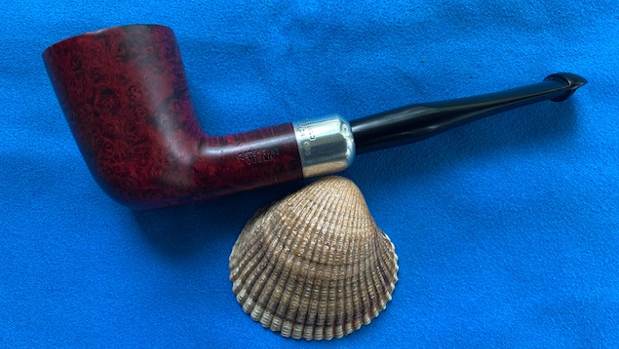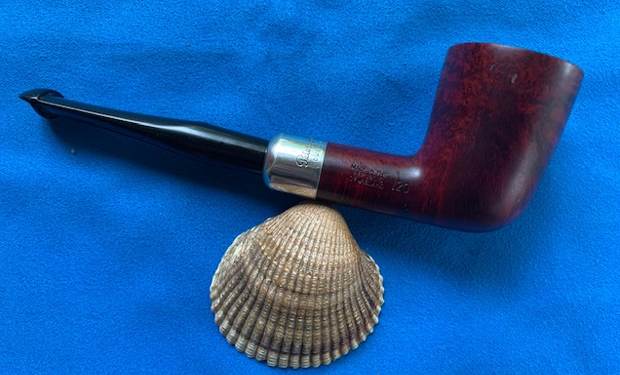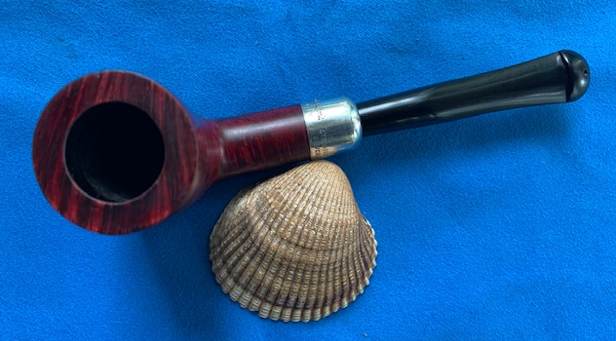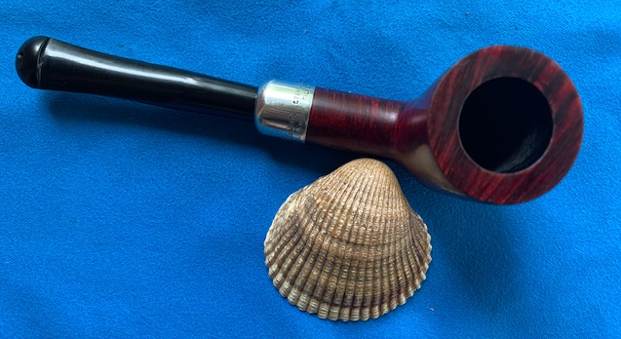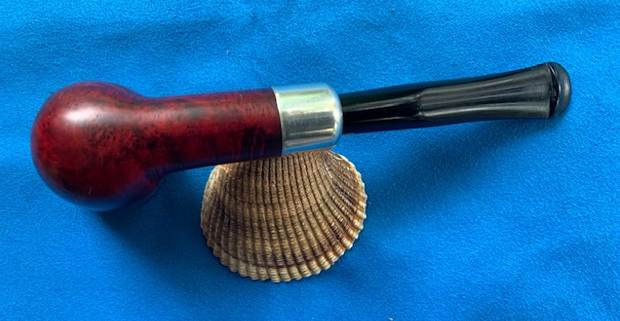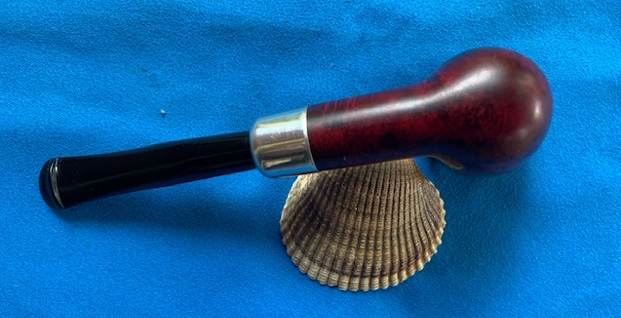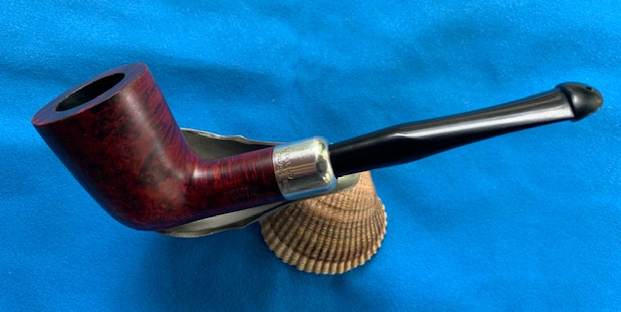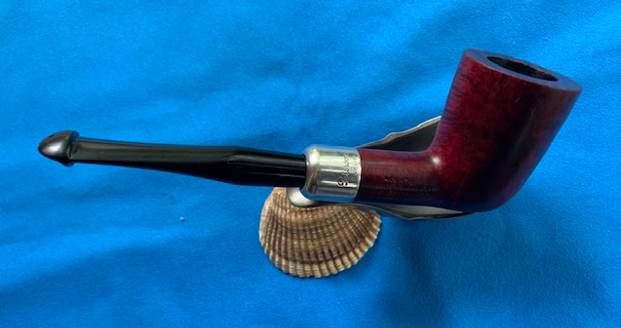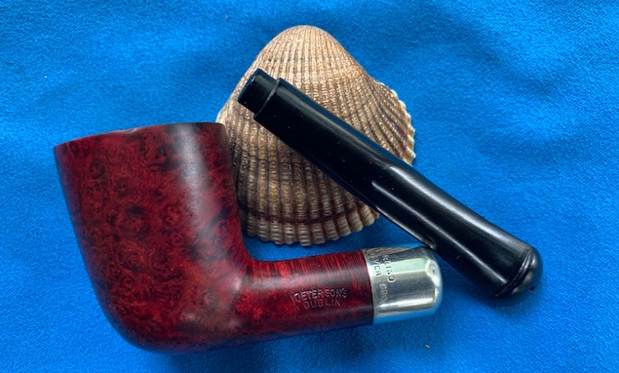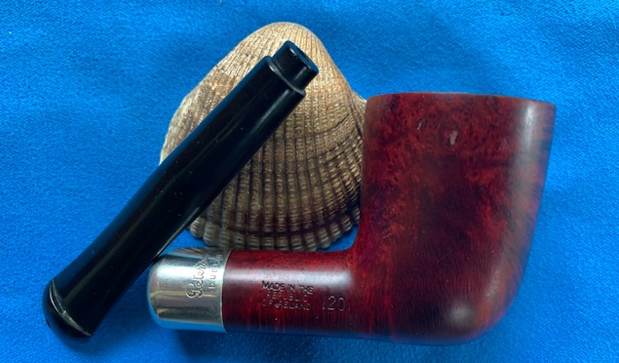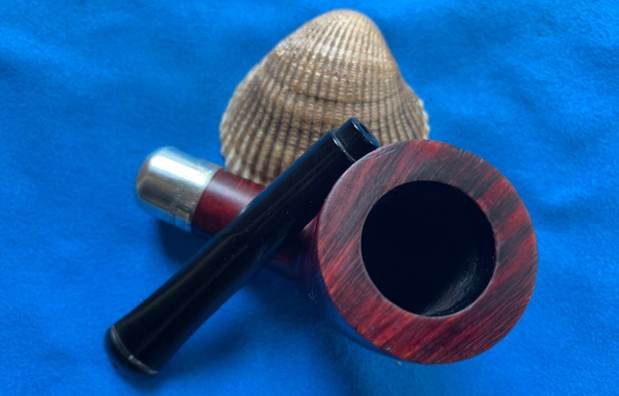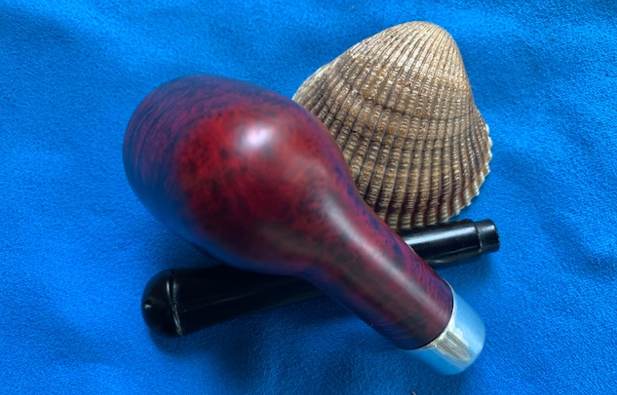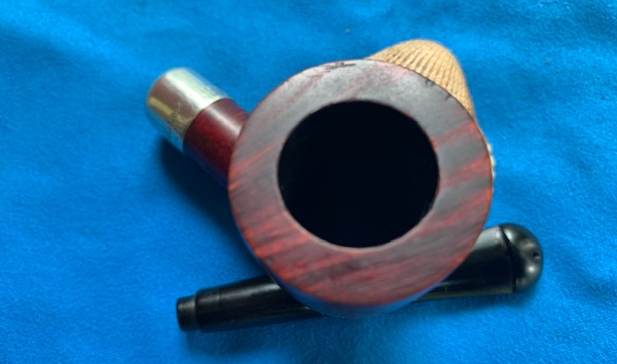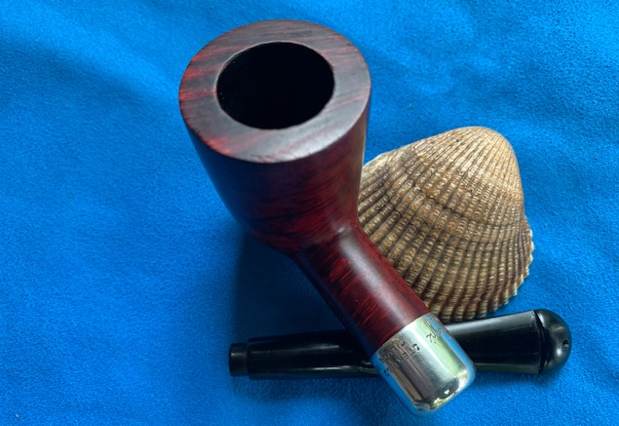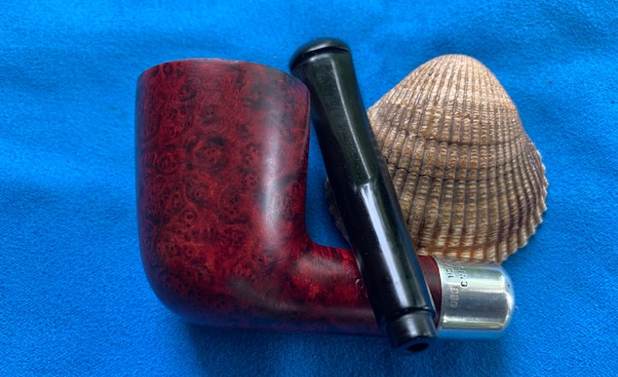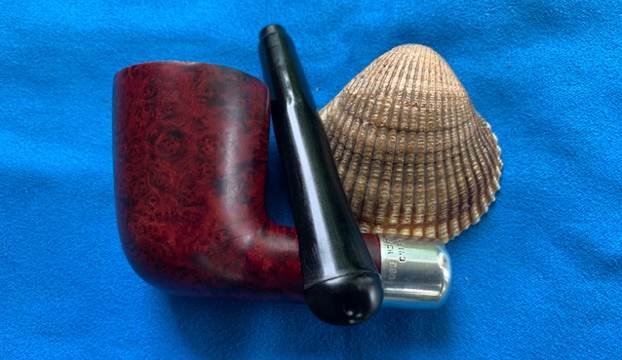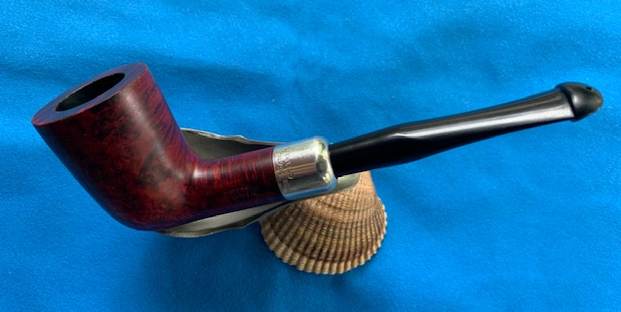Blog by Steve Laug
The next pipe I have chosen is another smooth finished Peterson’s Straight Dublin. This one is a smooth straight Dublin shape that has a rich coloured red finish around the bowl sides and shank. This pipe was purchased on 11/17/21 from a seller in San Marcos, Texas, USA. The finish is dark and dirty but there is some great grain around the bowl sides and shank. The briar has a few small nicks and flaws in the surface but is otherwise very nice. It was stamped on the left side of the shank and read Peterson’s [arched over] Dublin. It was stamped to the right of the shank and read MADE IN THE REPUBLIC OF IRELAND (three lines) with the shape number 120 next to the bowl. It was filthy when Jeff brought it to the table. There was a thick cake in the bowl and a thick overflow of lava on the rim top that was heavier on the back side. It was hard to know what the condition of the rim top and edge would be under that thick lava coat. The Sterling Silver ferrule is tarnished but was stamped Peterson’s [over] Dublin. That is followed by Sterling over Silver. Following the R in Silver were three hallmarks. The first was the seated woman (Hibernia), the second was a harp (the symbol for the grade of silver, the third is the letter B (the year stamp). The unstamped stem was lightly oxidized and had tooth marks and chatter on the top and underside on and near the button. Jeff took photos of the pipe before his cleanup work.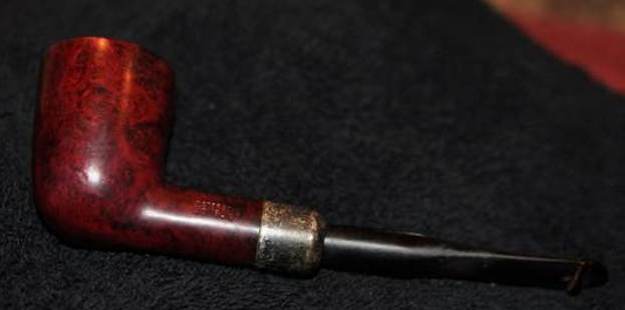
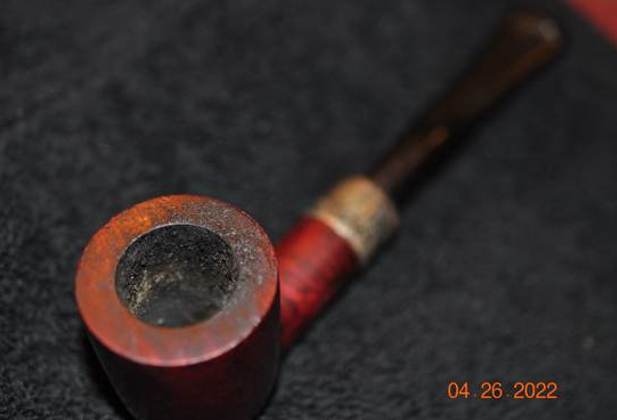 Jeff took photos of the rim top and stem to show the general condition of the pipe. The bowl is heavily caked and the rim top and edges have some lava overflow. The stem is lightly oxidized and has tooth marks on the top and underside near the button.
Jeff took photos of the rim top and stem to show the general condition of the pipe. The bowl is heavily caked and the rim top and edges have some lava overflow. The stem is lightly oxidized and has tooth marks on the top and underside near the button. 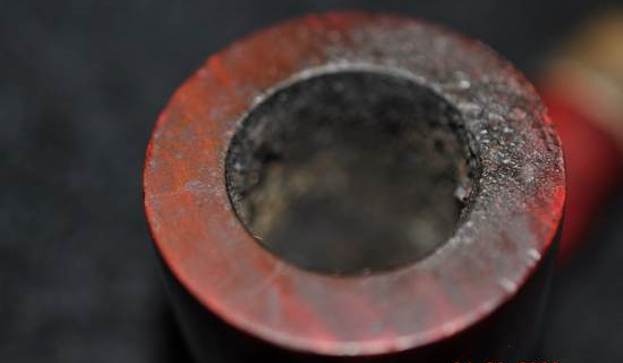
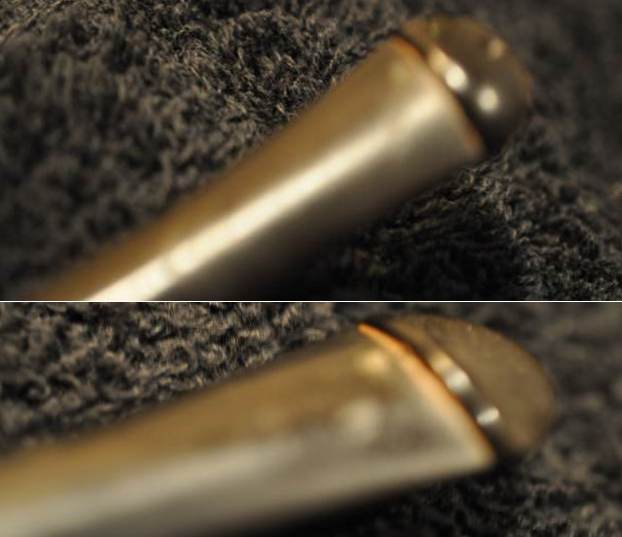 Jeff took photos of the bowl sides and heel to show the grain that was around this bowl. It is a nice looking pipe with great grain around the bowl.
Jeff took photos of the bowl sides and heel to show the grain that was around this bowl. It is a nice looking pipe with great grain around the bowl.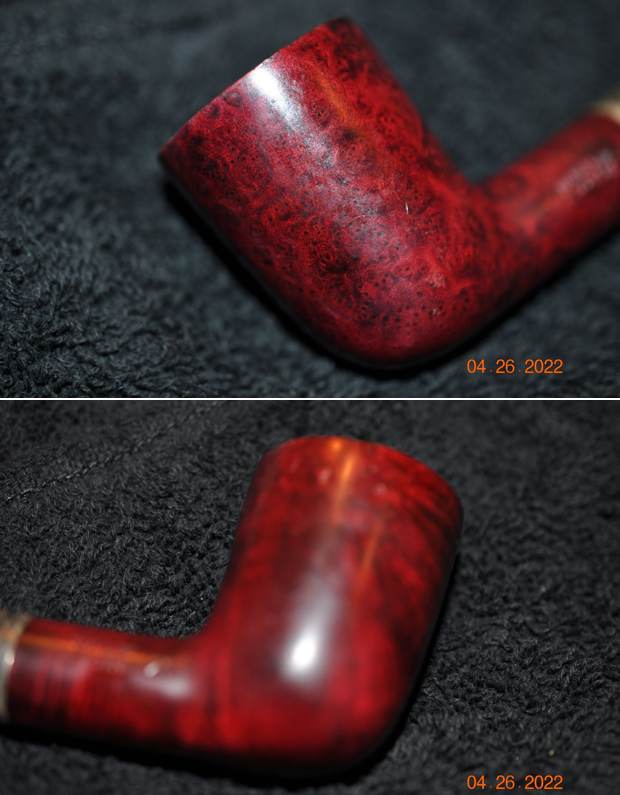
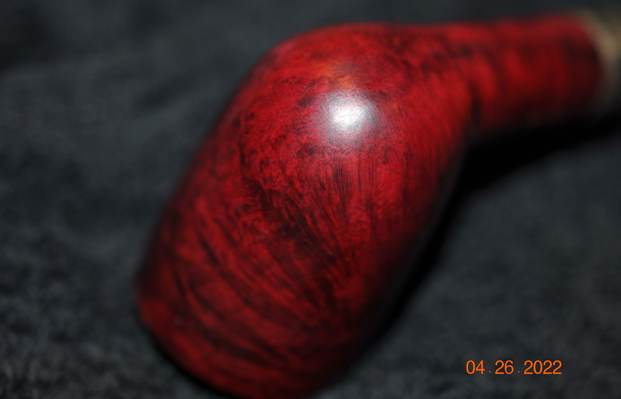 He took photos of the sides of the shank to show the stamping. The stamping is readable in the photos below and is as noted above.
He took photos of the sides of the shank to show the stamping. The stamping is readable in the photos below and is as noted above. 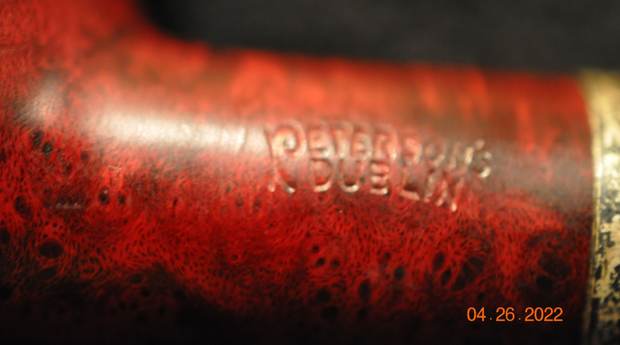
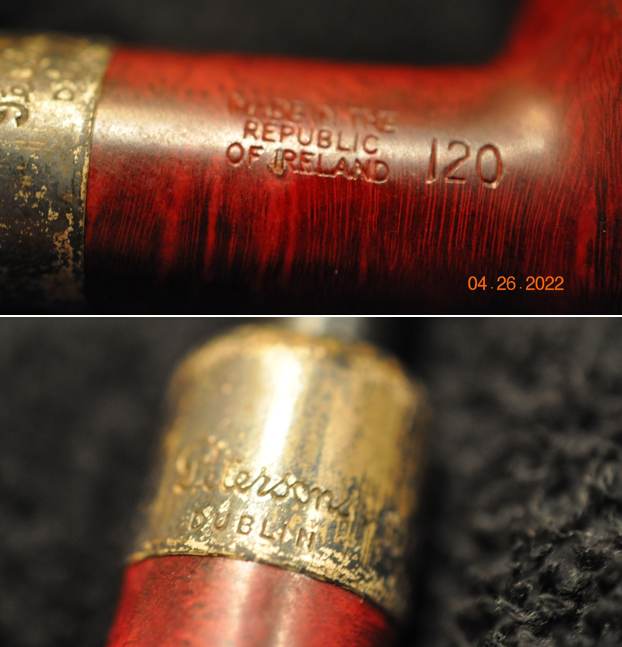 I am including the link to the Pipedia’s article on Peterson pipes. It is a great read in terms of the history of the brand (https://pipedia.org/wiki/Peterson).
I am including the link to the Pipedia’s article on Peterson pipes. It is a great read in terms of the history of the brand (https://pipedia.org/wiki/Peterson).
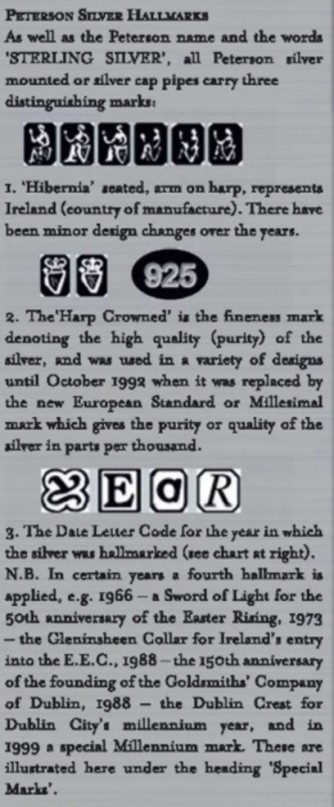 I decided to narrow down the date first before working on the pipe. I turned to a blog I had on rebornpipes on a silver ferrule that I had worked on previously (https://rebornpipes.com/tag/identifying-hallmarks-on-a-sterling-silver-ferrule/). I quote from that blog and include the graphics.
I decided to narrow down the date first before working on the pipe. I turned to a blog I had on rebornpipes on a silver ferrule that I had worked on previously (https://rebornpipes.com/tag/identifying-hallmarks-on-a-sterling-silver-ferrule/). I quote from that blog and include the graphics.
I always like to date the year a pipe was made while I am working on it. In the process of working on a pipe if I can pin down a date that it was made that it adds another dimension to the restoration process. Once I have identified the hallmarks on the pipe then I use a Hallmark chart to pin the date down. In the case of Peterson’s pipe with a silver band I use a hallmarking chart that Peterson included in their catalogs and on their website
I have a copy of the hallmark charts in one of the Peterson catalogs that I have uploaded to the blog on rebornpipes. I turned to that chart to lock down the date letter for the Sterling Silver Dublin that I am working on. Here is the link to the site (https://rebornpipes.com/wp-content/uploads/2015/05/peterson-cataloguecomp_page_27.jpg)
The chart defines the meaning of each hallmark on the silver band. The first one is of a seated woman with a harp is known as the Hibernia stamp and identifies the pipe as made in Ireland. The second stamp is a crowned harp which is a fineness mark denoting the high quality of silver that was used. The third stamp is the upper case italic letter “B”. I have included a larger screen capture of the section in the second photo below.
 I blew up the photo of the above chart so that I could read the dates. I have drawn a square around the proper date letter below. It identifies the date of manufacture this Peterson’s pipe to 1987.
I blew up the photo of the above chart so that I could read the dates. I have drawn a square around the proper date letter below. It identifies the date of manufacture this Peterson’s pipe to 1987. From the hallmarks it appeared that I was dealing with a pipe that the hallmarks date to 1987.
From the hallmarks it appeared that I was dealing with a pipe that the hallmarks date to 1987.
I turned them to “The Peterson Pipe” by Mark Irwin and Gary Malmberg to get some background on the Peterson’s Dublin 3. On page 298 it had the following information.
Dublin (1906-2003) Although DUBLIN appears under PETERSON’S on many pipe over the decades, it has served mostly as part of the brand name. The word first appeared on pipes hallmarked 1906-11, stamped PETERSON’S over PATENT over DUBLIN. The simpler PETERSON’S over DUBLIN first appeared on pipes hallmarked 1912 after the expiration of the patent. Illustrations of pipes in the ’37 catalog show a random dispersion of the stamp PETERSON’S over OF DUBLIN together with the ordinary PETERSON’S over DUBLIN on every model offered. Specimens of the former will bear either and Irish COM or LONDON MADE over ENGLAND COM and almost certainly date from 1945-62. It was first mentioned as part of a model name in the ’68 price list, as K&P DUBLIN, in ’92 for a Danish market line and in 2017 (see below).
I knew I was dealing with a pipe that had a long history of the stamping that I found on its shank. It is amazing to think that in a company that had a lot of anomalies in their stamping that the DUBLIN stamp continued from 1906-2003 and in other forms even longer. This 1987 made DUBLIN fits nicely within that time frame. Now it was time to work on the pipe.
Jeff had done a great job cleaning up the pipe as usual. He reamed the pipe with a PipNet reamer and cut back the cake back to the bare briar. He cleaned up the walls with a Savinelli Fitsall Pipe Knife. He scrubbed the interior of the bowl and shank with pipe cleaners, cotton swabs and alcohol to remove the tars and oils. He scrubbed the exterior of the pipe with Murphy’s Oil Soap and a tooth brush to remove the grime from the finish. He worked on the rim top lava and darkening with the soap and tooth brush. He scrubbed the inside of the stem with alcohol and pipe cleaners. He scrubbed the exterior with Soft Scrub and then soaked it in Briarville’s Pipe Stem Deoxidizer. He washed it off with warm water to remove the Deoxidizer. The pipe looked far better when it arrived.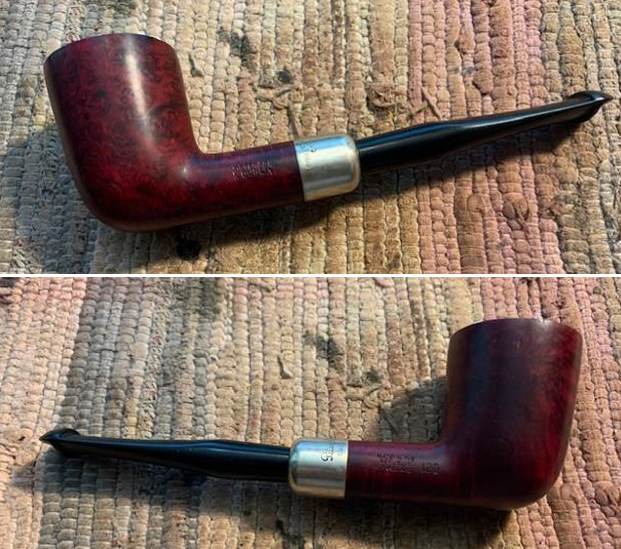
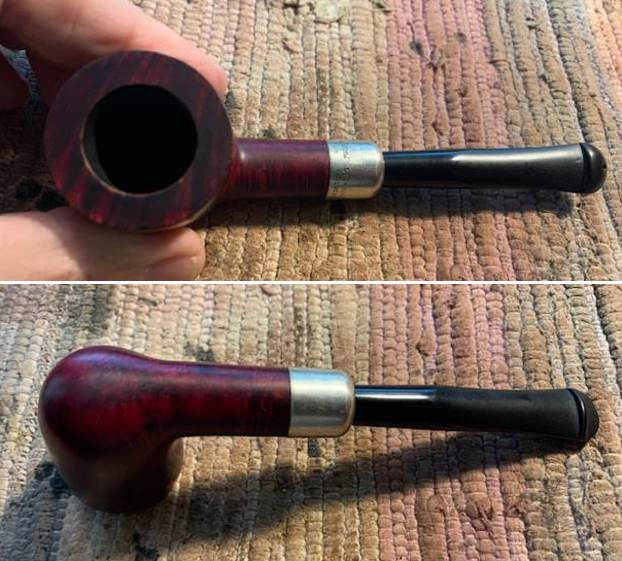 I took a close up photo of the rim top because I wanted to show how well it had cleaned up. The rim top looked amazingly good on the top and the inner and outer edges of the bowl. I also took close up photos of the stem to show the tooth marks on the surface near the button.
I took a close up photo of the rim top because I wanted to show how well it had cleaned up. The rim top looked amazingly good on the top and the inner and outer edges of the bowl. I also took close up photos of the stem to show the tooth marks on the surface near the button. 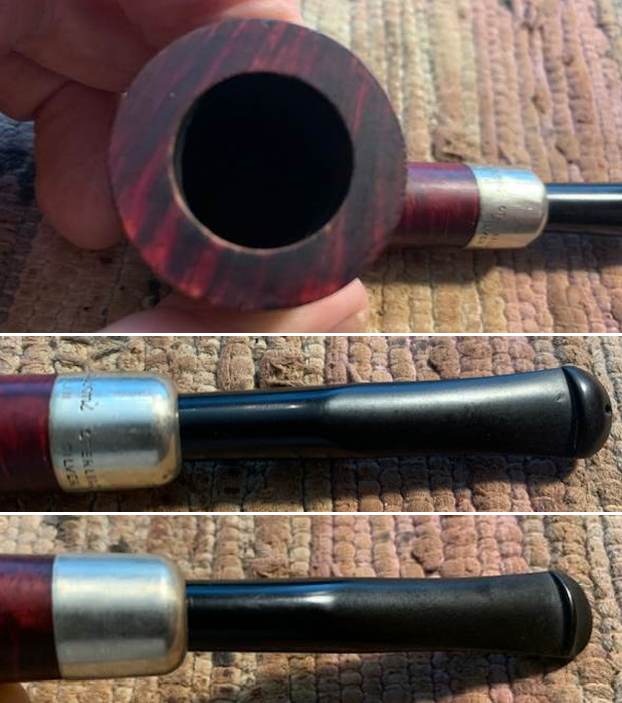 I took photos of the stamping on the sides of the shank. It reads as noted above.
I took photos of the stamping on the sides of the shank. It reads as noted above.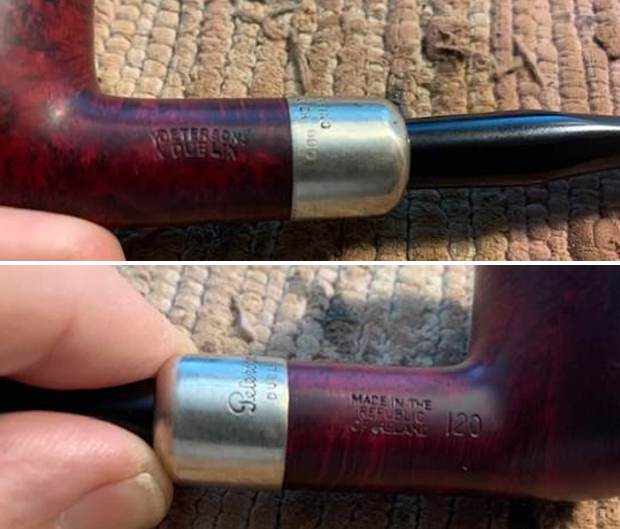 I removed the stem and took a photo of the pipe to have a look at the parts and overall look.
I removed the stem and took a photo of the pipe to have a look at the parts and overall look.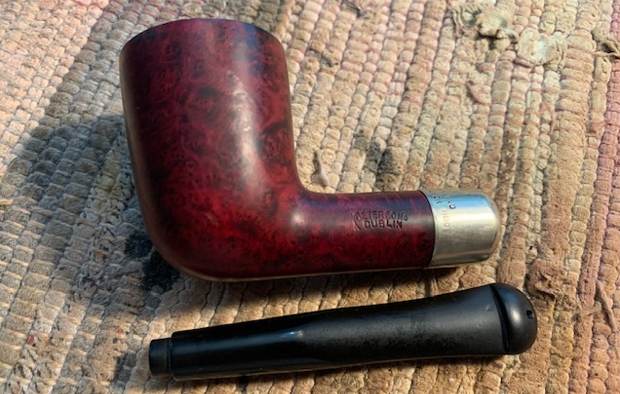 I sanded the bowl with micromesh sanding pads – dry sanding with 1500-12000 grit sanding pads to further make the stain more transparent and make the grain stand out. I wiped the bowl down with a damp cloth after each sanding pad.
I sanded the bowl with micromesh sanding pads – dry sanding with 1500-12000 grit sanding pads to further make the stain more transparent and make the grain stand out. I wiped the bowl down with a damp cloth after each sanding pad. 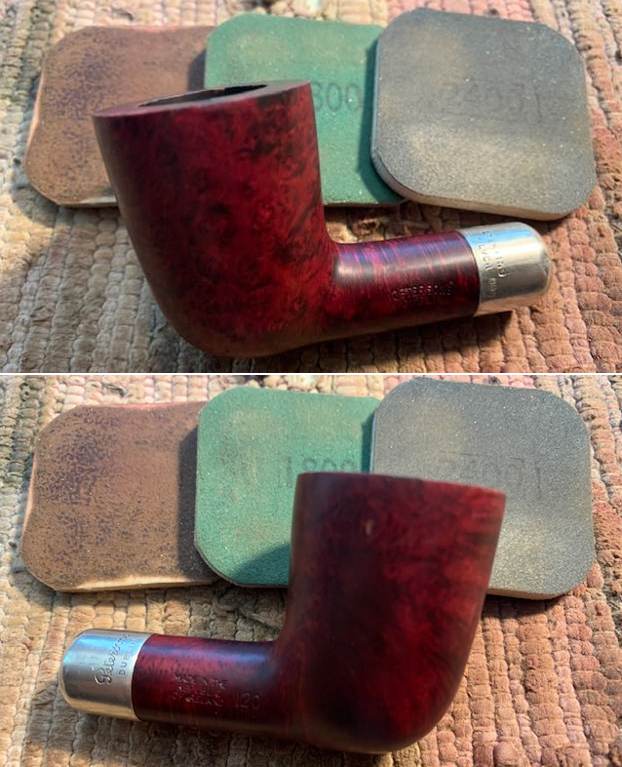
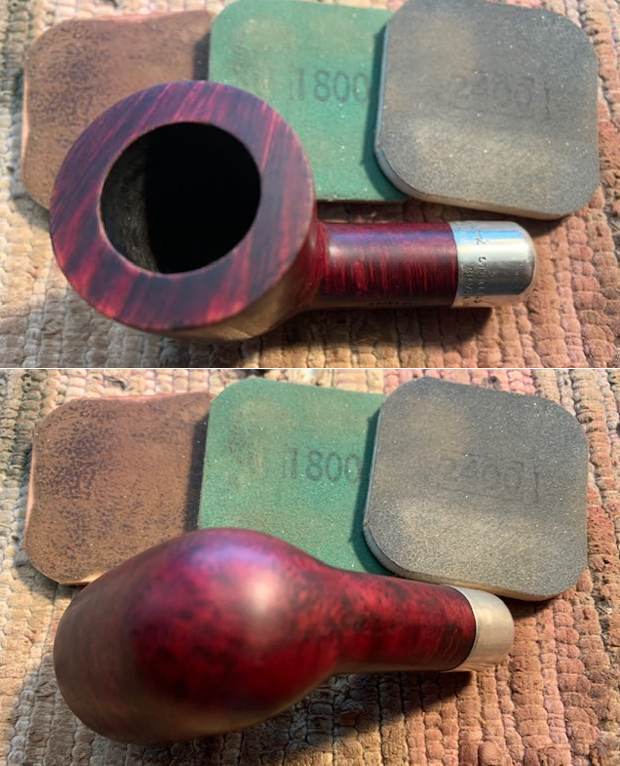
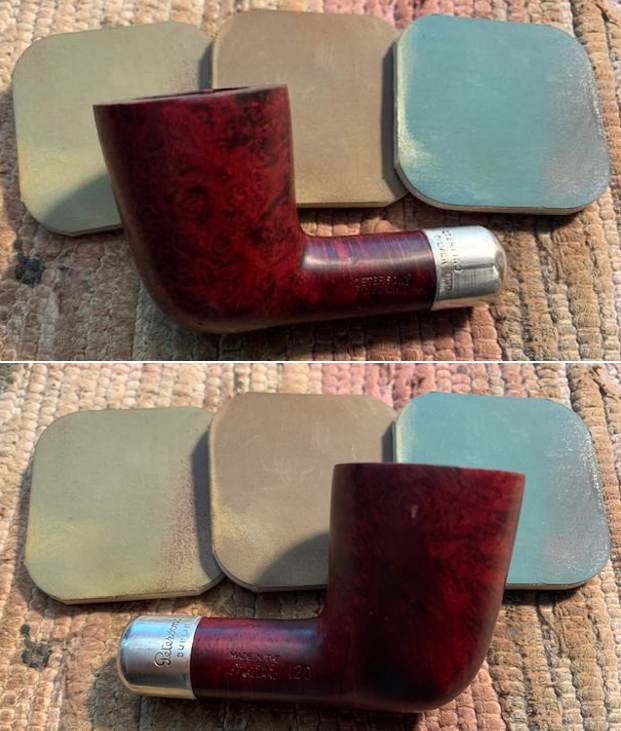
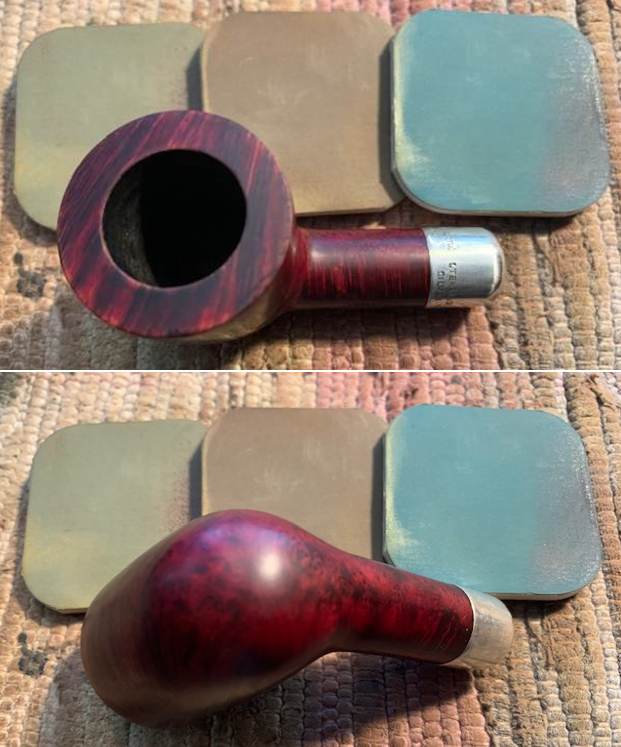
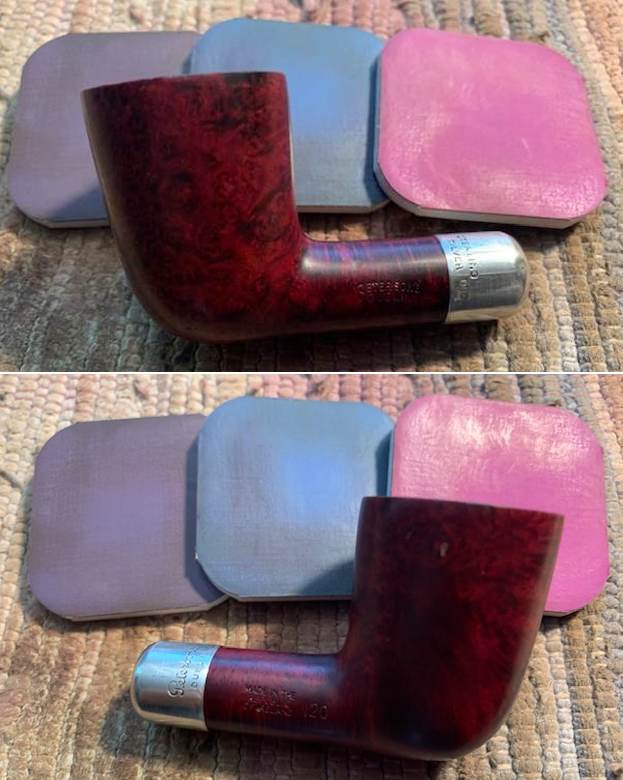
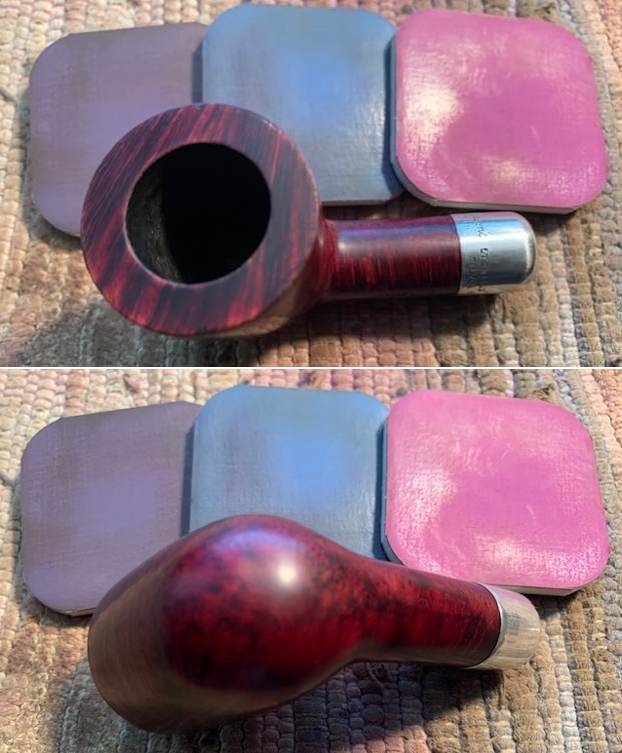 I worked some Before & After Restoration Balm into the surface of the briar with my fingertips to clean, enliven and protect the briar. I let the balm sit for 15 minutes and then buffed with a cotton cloth to raise the shine. The photos show the bowl at this point in the restoration process.
I worked some Before & After Restoration Balm into the surface of the briar with my fingertips to clean, enliven and protect the briar. I let the balm sit for 15 minutes and then buffed with a cotton cloth to raise the shine. The photos show the bowl at this point in the restoration process.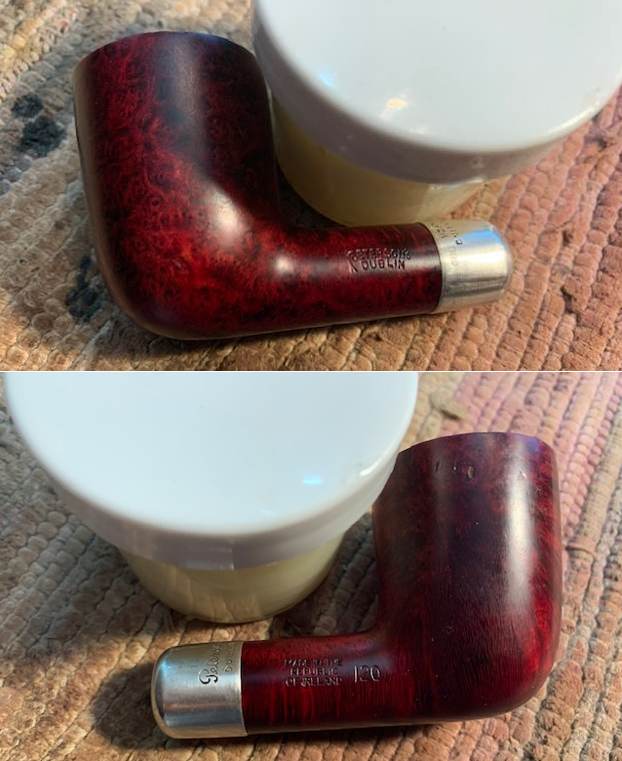
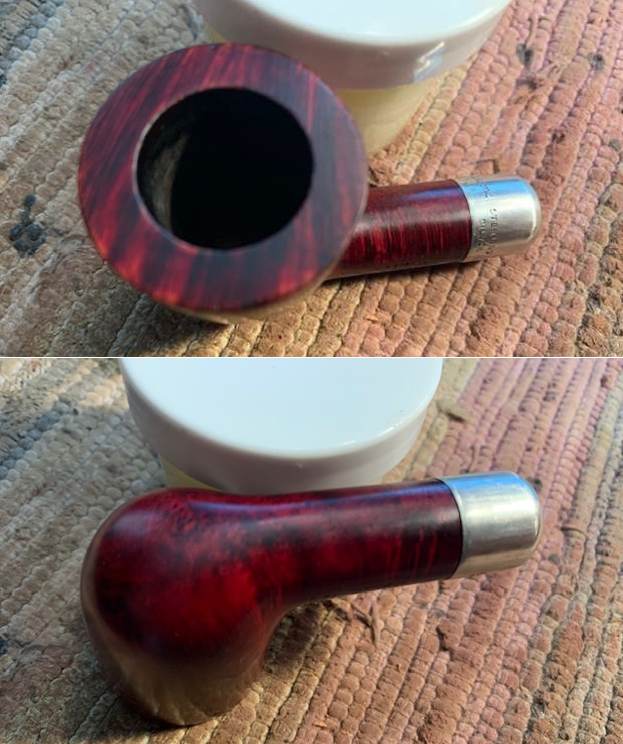
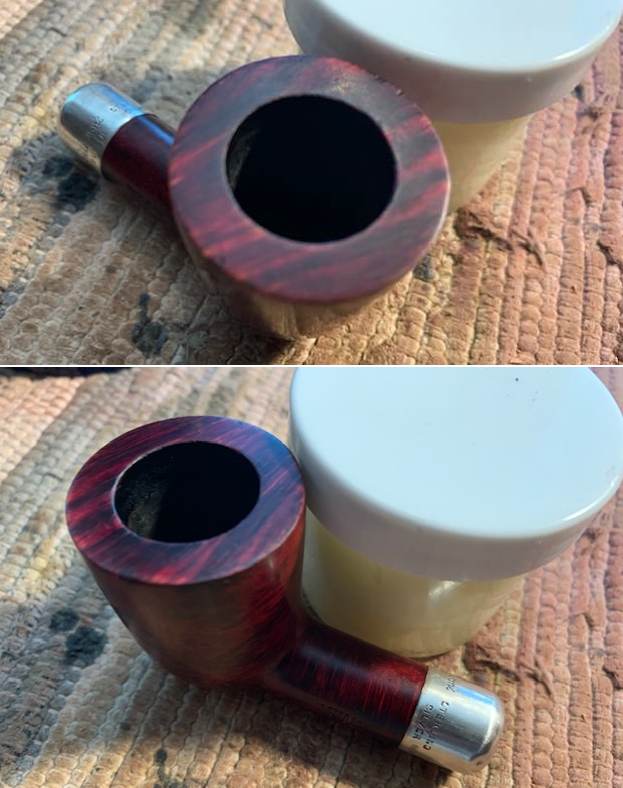 I polished the Sterling Silver Ferrule with a jeweler’s cloth to protect and give it a shine. It is a pretty looking pipe.
I polished the Sterling Silver Ferrule with a jeweler’s cloth to protect and give it a shine. It is a pretty looking pipe.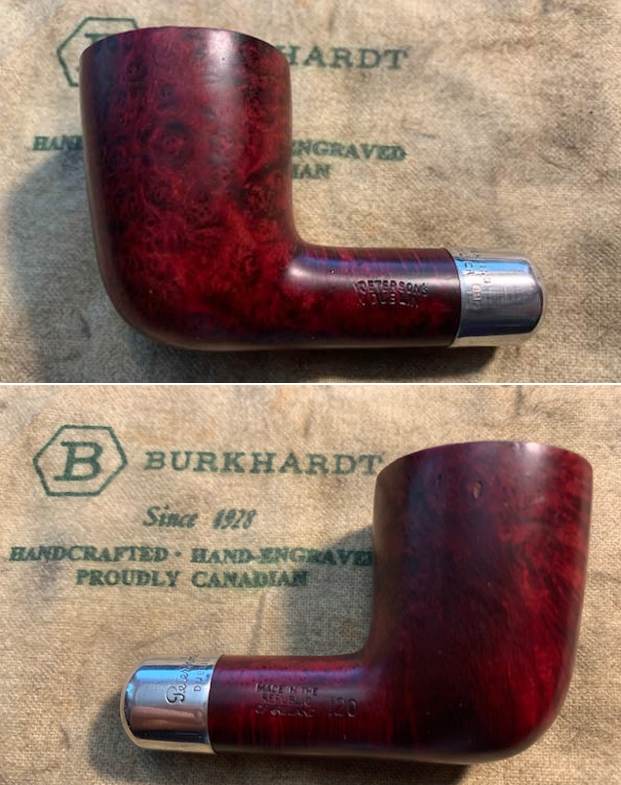
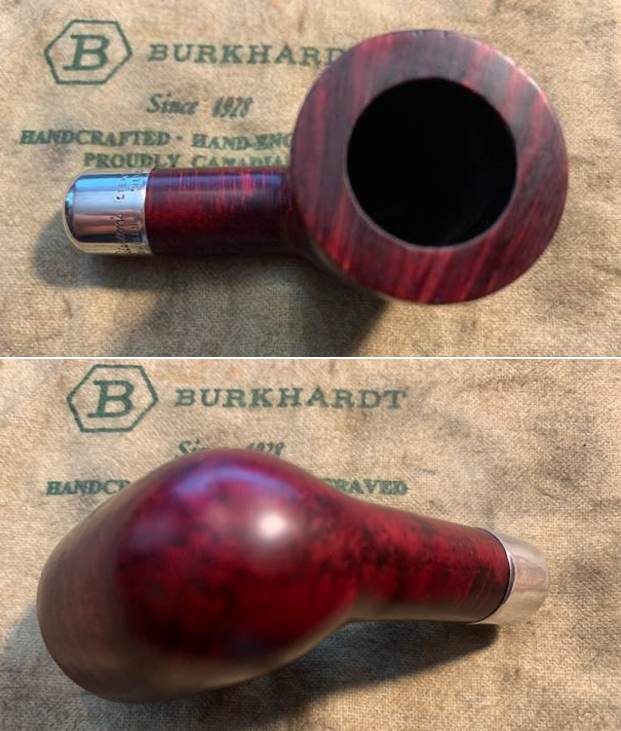 I “painted” the tooth marks in the stem with a lighter flame to lift the marks. Most lifted but I filled in the ones that remained on the top and underside of the stem next to the button edge with clear CA glue. Once the repairs cured I sanded them smooth with 220 grit sandpaper and started polishing it with 400 grit wet dry sandpaper. It was starting to look good.
I “painted” the tooth marks in the stem with a lighter flame to lift the marks. Most lifted but I filled in the ones that remained on the top and underside of the stem next to the button edge with clear CA glue. Once the repairs cured I sanded them smooth with 220 grit sandpaper and started polishing it with 400 grit wet dry sandpaper. It was starting to look good.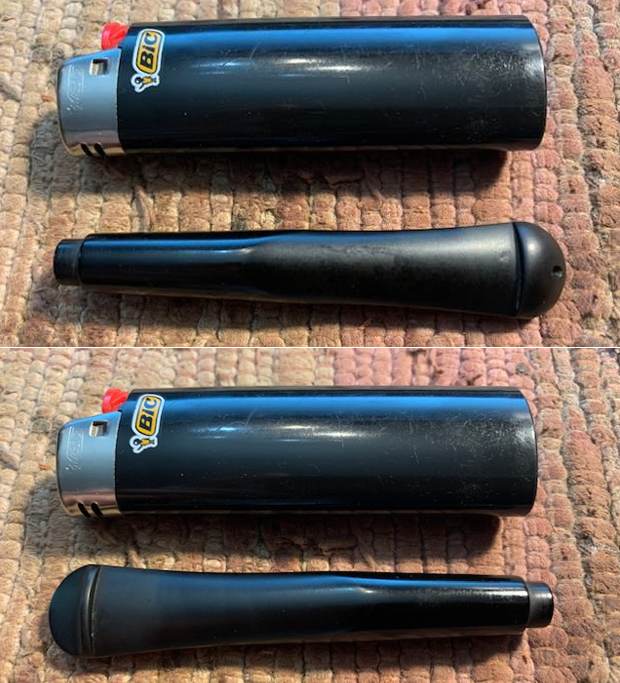
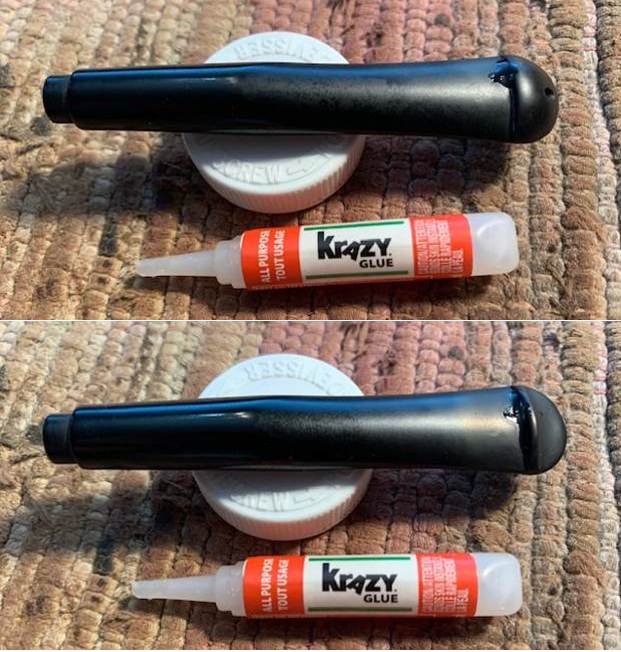
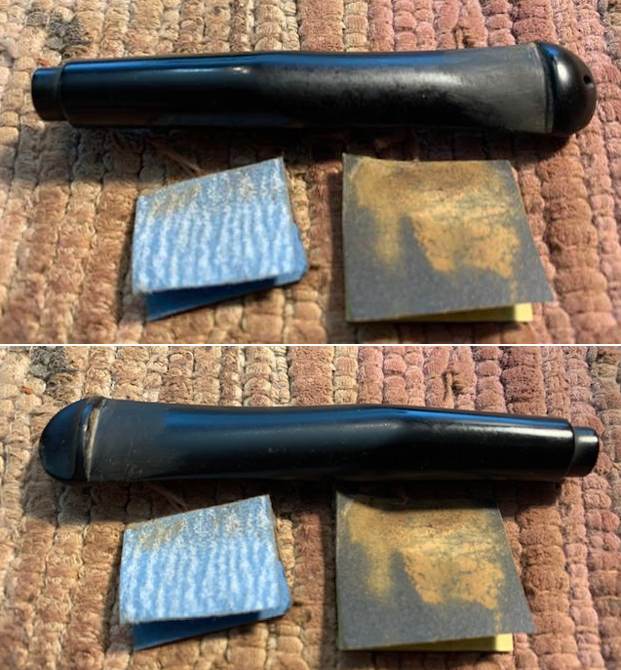 I polished the stem with micromesh sanding pads – wet sanding with 1500-12000 grit sanding pads. I wiped it down after each sanding pad with Obsidian Oil. I polished it with Before & After Pipe Stem Polish – both Fine and Extra Fine.
I polished the stem with micromesh sanding pads – wet sanding with 1500-12000 grit sanding pads. I wiped it down after each sanding pad with Obsidian Oil. I polished it with Before & After Pipe Stem Polish – both Fine and Extra Fine. 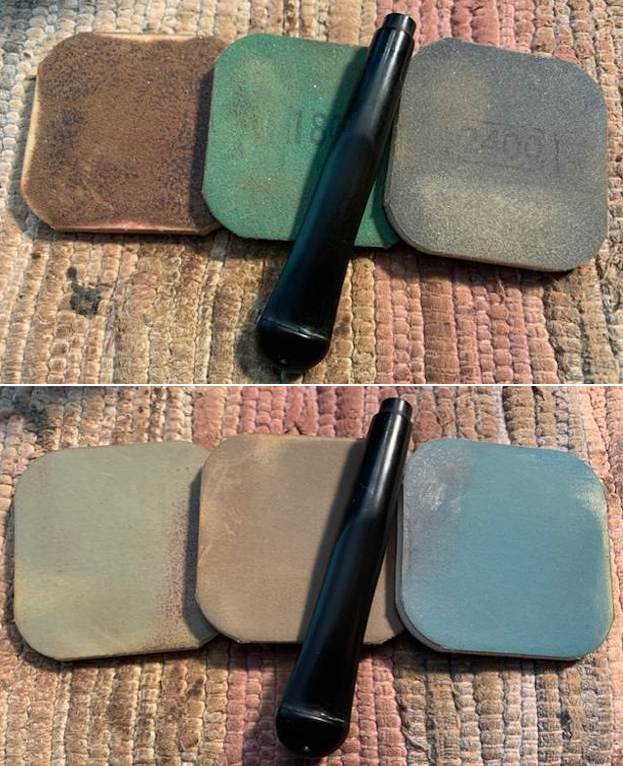
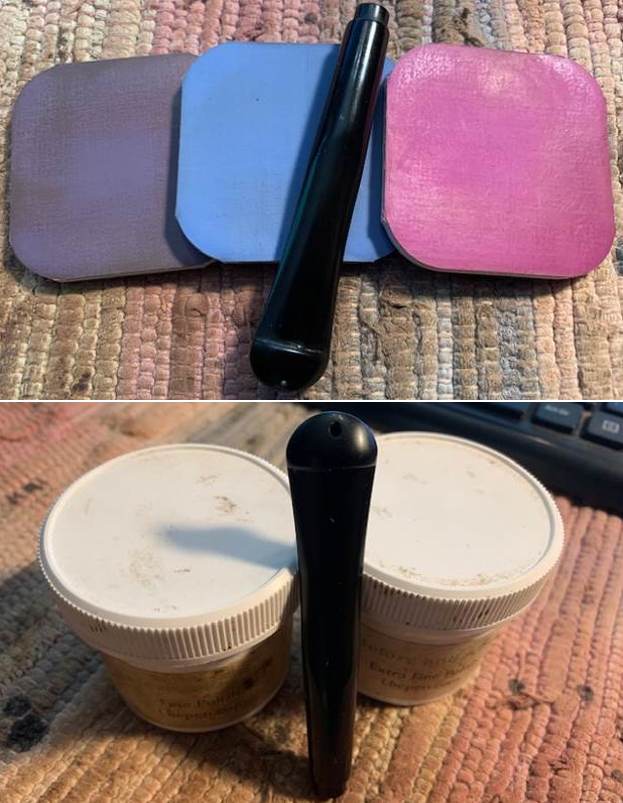 I am excited to finish this Peterson’s Dublin 120 Straight Dublin. I put the pipe back together and buffed it with Blue Diamond on the buffing wheel. I gave the bowl and the stem multiple coats of carnauba wax. I hand buffed the pipe with a clean buffing pad to raise the shine. It is fun to see what the polished bowl looks like with beautiful straight and flame grain all around it. Added to that the polished black vulcanite stem was beautiful. This smooth Classic Peterson’s 120 Dublin is great looking and the pipe feels great in my hand. It is light and well balanced. Have a look at it with the photos below. The dimensions are Length: 5 ¾ inches, Height: 1 ¾ inches, Outside diameter of the bowl: 1 ¼ inches, Chamber diameter: ¾ of an inch. The weight of the pipe is 35 grams/1.23 ounces. It is a beautiful pipe and one that will soon be on the rebornpipes store in the Irish Pipe Makers Section of the store. If you want to add it to your collection let me know. Thanks for walking through the restoration with me as I worked over this pipe. Thanks to each of you who are reading this blog.
I am excited to finish this Peterson’s Dublin 120 Straight Dublin. I put the pipe back together and buffed it with Blue Diamond on the buffing wheel. I gave the bowl and the stem multiple coats of carnauba wax. I hand buffed the pipe with a clean buffing pad to raise the shine. It is fun to see what the polished bowl looks like with beautiful straight and flame grain all around it. Added to that the polished black vulcanite stem was beautiful. This smooth Classic Peterson’s 120 Dublin is great looking and the pipe feels great in my hand. It is light and well balanced. Have a look at it with the photos below. The dimensions are Length: 5 ¾ inches, Height: 1 ¾ inches, Outside diameter of the bowl: 1 ¼ inches, Chamber diameter: ¾ of an inch. The weight of the pipe is 35 grams/1.23 ounces. It is a beautiful pipe and one that will soon be on the rebornpipes store in the Irish Pipe Makers Section of the store. If you want to add it to your collection let me know. Thanks for walking through the restoration with me as I worked over this pipe. Thanks to each of you who are reading this blog.